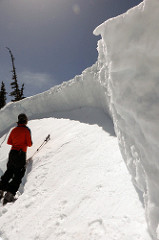Every year we hear tragic stories about backcountry recreationalists killed and injured in avalanches. But this risk also affects workers in or near avalanche zones.
Since 1998 in B.C., avalanches have caused three worker deaths and 47 accepted time-loss injury claims. Most worked in the ski hill and winter lodge industries, but a land surveyor and a truck driver were also injured.

“Avalanche” by Washington State Dept of Transport
“The avalanche doesn’t really care if we’re a worker or a recreationalist,” says Carole Savage, a WorkSafeBC forest industry specialist and active member of the Canadian Avalanche Association.
“We wanted to bring the awareness up for other industries like oil and gas, forestry, road construction, and hydroelectric just to get people thinking about it,” Carole says, referring to WorkSafeBC’s recent media release Unstable snowpack can put workers at risk.
Occupational Health and Safety Regulation Section 4.1.1 requires all employers whose workers travel through, work around, or within a potential avalanche hazard zone to have a qualified person conduct an evaluation risk assessment. If a risk exists, the employer needs an avalanche safety plan or program – depending on the circumstances – developed by a qualified person to either eliminate or minimize workers’ exposure to avalanche risk. Read more about it in “A route to reducing avalanche risks” the cover story of WorkSafe Magazine, Jan/Feb 2016.
Carole describes some common misconceptions people have about avalanches.
“Often people don’t know what they don’t know when it comes to what avalanche terrain is and what it’s not,” she says. “The average person may think about avalanches as something that just happens on big mountainsides. Basically it can happen in anything that is steep enough to slide under conditions that could produce an avalanche. Snow stability can change very quickly and this can take people by surprise also.”
Carole advises employers to contact their local prevention officer if they have questions about avalanche risk for workers and what steps to take next. Depending on the situation, employers may need to contact a qualified person who can conduct a risk assessment and develop measures needed to address the risks.
“If you’re looking for a qualified person, and you don’t really know where to start, my suggestion is to contact the Canadian Avalanche Association,” Carole says.
You can reach the Prevention Information Line at 604 276-3100 in the Lower Mainland, or at 1 888 621-7233 toll-free within B.C. and Alberta. Thanks to Carole for talking with me about this.


